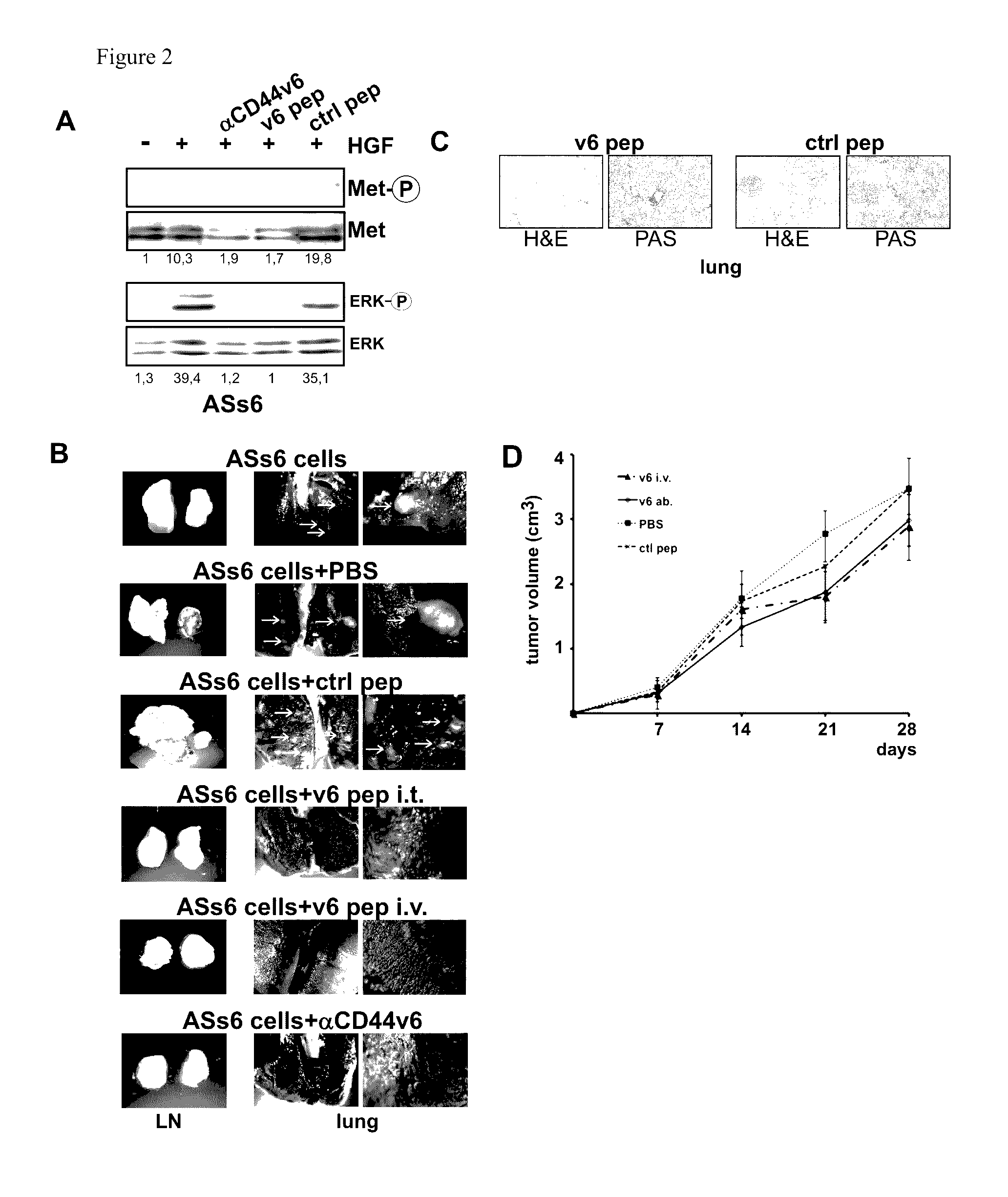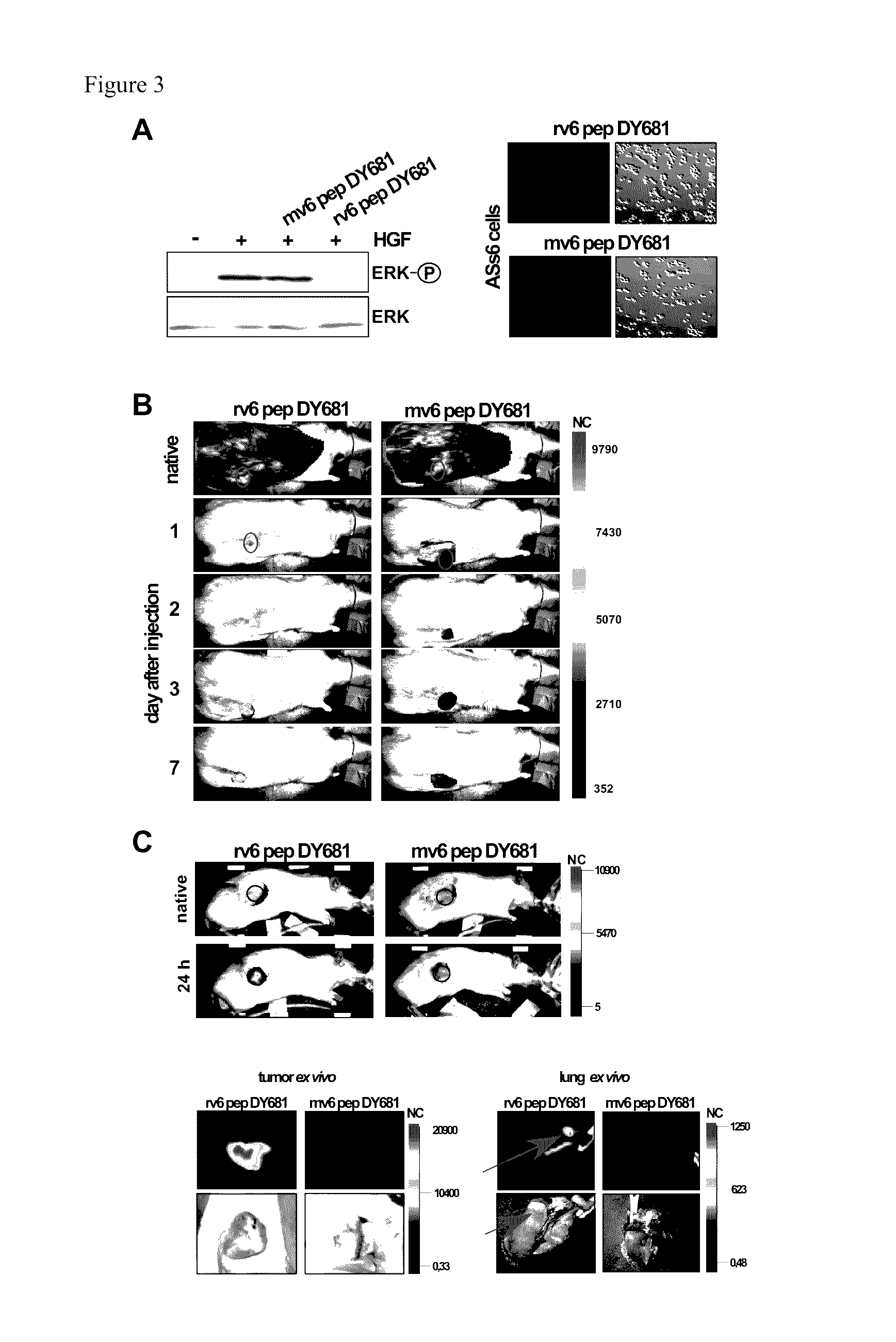CD44v6-derived peptides for treating pancreatic cancer
a peptide and pancreatic cancer technology, applied in the direction of peptides, peptide/protein ingredients, drug compositions, etc., can solve the problems of no treatment currently available and long-term progression-free survival, and achieve the effect of preventing the formation of metastases
- Summary
- Abstract
- Description
- Claims
- Application Information
AI Technical Summary
Benefits of technology
Problems solved by technology
Method used
Image
Examples
example 1
1. Material and Methods
Cell Lines
[0111]The rat pancreatic carcinoma cell line BSp73AS (also designated AS) and its transfectants have been described (Orian-Rousseau et al., Genes &Development (2002), 16:3074-3086) and were grown in RPMI (Invitrogen, Karlsruhe, Germany) plus 10% FCS (PAA, Cölbe, Germany). The human pancreatic cancer cells L3.6p1 (Bruns et al., Neoplasia (1999), 1, 50-62) were maintained in DMEM (low glucose; Invitrogen, Karlsruhe, Germany) supplemented with 10% FCS (PAA, Cölbe, Germany), sodium pyruvate, nonessential amino acids, L-glutamine, and MEM vitamin solution (Pan Biotech, Aidenbach Germany).
Antibodies and Other Reagents
[0112]The human monoclonal antibody against CD44v6 (VFF18) was a gift from Bender (eBioscience, Campus Vienna Biocenter 2, A-1030, Vienna, Austria), the anti-ERK 1 (K-23), c-Met (C-28) and GFP antibody (sc-101525) were from Santa Cruz Biotechnology (Heidelberg, Germany), the cleaved Caspase-8 antibody (IMG-5703) from Imgenex (San Diego, Calif....
example 2
Pegylated CD44v6 Peptides Inhibit HGF Dependent CD44v6 Mediated Signaling
1. Material and Methods
Synthesis of Pegylated Peptides
[0141]Peptide synthesis was performed on an Applied Biosystems automated peptide synthesizer (model 433A) and the peptides were purified by preparative HPLC. Peptides of sequences NEWQG (SEQ ID NO: 11) and a control peptide NAAAG (SEQ ID NO: 15) were synthesized. Crude and purified products were characterized by LC coupled to a mass spectrometer (μTOF LCMS from Bruker Daltonics-Bremen, Germany).
[0142]Peptide synthesis was performed using standard Fmoc solid phase peptide synthesis protocols (see e.g. Fields et al., Int J Pept Protein Res. (1990), 35, 161-214, Maisch et al., J Am Chem Sco. (2009), 131, 15596-15597, Strandberg et al., Biophys J. (2006), 90, 1676-1686, and Wadhwani et al., J Org Chem. (2006), 71, 55-61). Fmoc deprotection was done with 20-22% piperidine in NMP. Coupling was performed using a mixture of Fmoc-amino acid:HOBt: HBTU:DIEA (4:4:3.9:8...
example 3
In Vitro Results
Linear CD44v6 Peptides Described Herein
[0157]rat: 14mer KEKWFENEWQGKNP (SEQ ID NO: 10), 5mer NEWQG (SEQ ID NO: 11), DY681 labeled 11mer WFENEWQGKNP (DY681-SEQ ID NO: 12)
[0158]human: 14mer KEQWFGNRWHEGYR (SEQ ID NO: 6), 5mer NRWHE (SEQ ID NO: 2), DY681 labeled 11mer WFGNRWHEGYR (DY681-SEQ ID NO: 14)
[0159]mouse: DY681 labeled 11mer WFQNGWQGKNP (DY681-SEQ ID NO: 13)
1. In Vitro Inhibition of RTKs Using the Human v6 Peptides
[0160]Linear peptide (human, 14mer KEQWFGNRWHEGYR (SEQ ID NO: 6), 5mer NRWHE (SEQ ID NO: 2))
Cell Lines Used
[0161]HT29 (colorectal cancer)
[0162]HeLa (cervical cancer)
[0163]L3.6p1 (human pancreatic carcinoma cell)
[0164]MCF7 (human breast cancer)
1.1 Epithelial Cells
[0165]The contribution of CD44v6 to Met signaling in the human epithelial pancreatic cancer cells L3.6p1 (derived from Colo 357), the cervix carcinoma cells HeLa and the colon cancer cells HT29 were analysed using the CD44v6 peptide (v6 14mer; v6 5mer tested as well, data not shown). It was abl...
PUM
| Property | Measurement | Unit |
|---|---|---|
| time | aaaaa | aaaaa |
| molecular weight | aaaaa | aaaaa |
| molecular weight | aaaaa | aaaaa |
Abstract
Description
Claims
Application Information
 Login to View More
Login to View More - R&D
- Intellectual Property
- Life Sciences
- Materials
- Tech Scout
- Unparalleled Data Quality
- Higher Quality Content
- 60% Fewer Hallucinations
Browse by: Latest US Patents, China's latest patents, Technical Efficacy Thesaurus, Application Domain, Technology Topic, Popular Technical Reports.
© 2025 PatSnap. All rights reserved.Legal|Privacy policy|Modern Slavery Act Transparency Statement|Sitemap|About US| Contact US: help@patsnap.com



